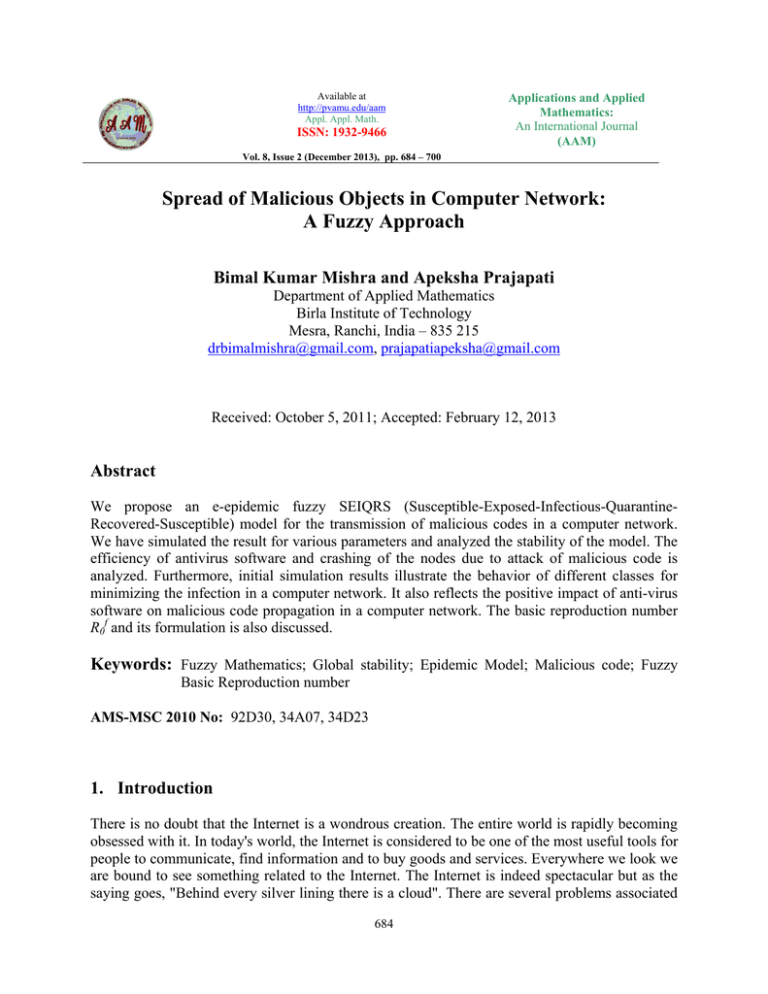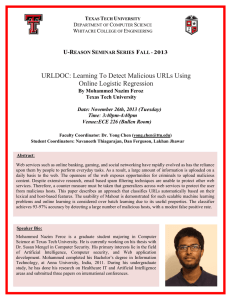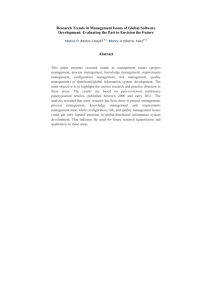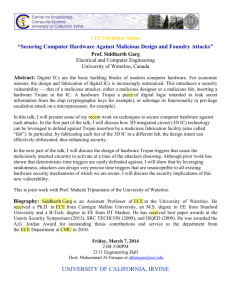Spread of Malicious Objects in Computer Network: A Fuzzy Approach
advertisement

Available at
http://pvamu.edu/aam
Appl. Appl. Math.
ISSN: 1932-9466
Applications and Applied
Mathematics:
An International Journal
(AAM)
Vol. 8, Issue 2 (December 2013), pp. 684 – 700
Spread of Malicious Objects in Computer Network:
A Fuzzy Approach
Bimal Kumar Mishra and Apeksha Prajapati
Department of Applied Mathematics
Birla Institute of Technology
Mesra, Ranchi, India – 835 215
drbimalmishra@gmail.com, prajapatiapeksha@gmail.com
Received: October 5, 2011; Accepted: February 12, 2013
Abstract
We propose an e-epidemic fuzzy SEIQRS (Susceptible-Exposed-Infectious-QuarantineRecovered-Susceptible) model for the transmission of malicious codes in a computer network.
We have simulated the result for various parameters and analyzed the stability of the model. The
efficiency of antivirus software and crashing of the nodes due to attack of malicious code is
analyzed. Furthermore, initial simulation results illustrate the behavior of different classes for
minimizing the infection in a computer network. It also reflects the positive impact of anti-virus
software on malicious code propagation in a computer network. The basic reproduction number
R0f and its formulation is also discussed.
Keywords: Fuzzy Mathematics; Global stability; Epidemic Model; Malicious code; Fuzzy
Basic Reproduction number
AMS-MSC 2010 No: 92D30, 34A07, 34D23
1. Introduction
There is no doubt that the Internet is a wondrous creation. The entire world is rapidly becoming
obsessed with it. In today's world, the Internet is considered to be one of the most useful tools for
people to communicate, find information and to buy goods and services. Everywhere we look we
are bound to see something related to the Internet. The Internet is indeed spectacular but as the
saying goes, "Behind every silver lining there is a cloud". There are several problems associated
684
AAM: Intern. J., Vol. 8, Issue 2 (December 2013)
685
with the Internet. All financial dealings are made over the Internet. It is estimated that billions or
even trillions of dollars are being exchanged online every day. This has spawned a new
generation of criminals. These cyber criminals develop programs or software called malicious
codes that invade our personal computers and start gathering information such as our financial or
personal details. We can stop these crimes from happening by simply installing the best Internet
security software available.
Epidemic systems in particular, those dealing with infectious diseases, have strong nonlinearities and should be treated in a different way. These non-linearities are due to the fact that
the force of epidemic of an infectious agent, among other things, depends on the fraction of
susceptible nodes and fraction of infectious nodes. Both susceptibility and infectiousness are
intrinsically fuzzy concepts as suggested by Mishra and Pandey (2010) and therefore, ideal
subjects for fuzzy logic analysis. The mathematical models of transmission of malicious object in
a computer network are always subject to inaccuracies related to the nature of the state variables
involved, parameters and initial conditions.
In this paper we extend the SIRS model studied by Mishra and Pandey (2010), by introducing
two new compartments, viz. Exposed and Quarantine classes and analyze the effect. In this
model we have used fuzzy logic, which helps us to explain the transmission of malicious code
more accurately. Recently, more research attention has been paid towards modeling the
combined propagation of malicious codes and also anti-virus countermeasures to control the
dominance of malicious codes. Examples include virus immunization studied by Mishra and Jha
(2007), Pastor-Satorras and Vespignani (2002), Kephart (1995) and quarantine as a control
measure which has been dealt by Mishra et al. (2009), Chen and Jamil (2006) and also by
Kephart et al. (1993).
More work has also been done on the spread and vaccination of virus in email networks by Han
and Tan (2010), Newman et al. (2002) and by Datta and Wang (2005) as well. Thresholds for
virus propagation in the network have also been calculated, for instance by Draief et al. (2008).
There is an ample amount of literature on different models in epidemiology including the work
of Kephart et al. (1993), Keeling and Eames (2005), Li and Zhen (2004) and Kermack and
McKendrick (1927). Most of these models use the work of Kermack and McKendrick (1927,
1932, 1933) as basis where they studied the SIR classical epidemic model.
The similarity between the spread of a biological virus and malicious code propagation
encourages researchers to adopt epidemic models like SIS (Susceptible-Infectious-Susceptible),
SEIRS (Susceptible-Exposed-Infectious-Recovered-Susceptible), SEIQRS (SusceptibleExposed-Infectious-Quarantined-Recovered-Susceptible) and SEIQAmS (Susceptible-ExposedInfectious-Quarantined-Anti Malicious Software treated-Susceptible) in modeling computer
viruses and worms, as has been done by Mishra and Jha (2010), Mishra and Saini (2007), Han
and Tan (2010), Kim et al. (2006), Picqueria (2009), Williamson and Laeveillae (2003) and
Jones (2007).
Dynamical models for malicious objects propagation were proposed, providing estimations for
temporal evolutions of nodes depending on network parameters by May and Lloyd (2001) and
686
Bimal Kumar Mishra and Apeksha Prajapati
later by Zou et al. (2003). A key concept in almost all of these studies is the basic reproduction
number , which has been elaborately discussed by Mishra and Jha (2007, 2010) and also by
Mishra and Saini (2007). It basically denotes the expected number of secondary infections
1, the infection spreads to some sizeable fraction of
caused by a single primary infective. If
the entire population and if
1, then the infection eventually becomes zero.
2. Formulation of Fuzzy SEIQRS Model
2.1. The Simple SEIQRS Model
A simple classical e-epidemic SEIQRS model illustrates the dynamics of direct transmission of
malicious codes among susceptible, exposed, infected, quarantined and recovered classes of
nodes in the computer network. We have assumed that there is neither vital dynamics nor
crashing of nodes due to other reason in the network. The flow of malicious codes in a computer
network is depicted in Figure 1.
δR
βSI
ξE
ηI
γQ
I
αI
Figure 1. The flow of malicious codes in different classes in a computer network
The system of ordinary differential equations representing this model is given as follows:
,
,
, ,
,
where
1.
(A)
AAM: Intern. J., Vol. 8, Issue 2 (December 2013)
687
In this model constant population is divided into different classes based on the status of nodes. S
is the class of proportional susceptible nodes. E is the class of proportional exposed nodes, which
contains those nodes that are infectious but are still not able to transmit malicious codes to other
nodes. I is the class of proportional infectious nodes while Q is the class of proportional
quarantined nodes. The nodes which are highly infectious are quarantined from the network. R is
the class of proportional recovered nodes. β is the infectivity contact rate, ξ is the rate at which
exposed population becomes infectious, γ is the recovery rate in quarantine class, α is the
recovery rate in infectious class, is the rate of quarantine and δ is the rate of loss of immunity
of the nodes. We now consider an expansion of the SEIQRS dynamic model incorporating
heterogeneities, taking into account that nodes with different amount of malicious code
contribute differently to the malicious code transmission.
2.2. The Fuzzy SEIQRS Model
All concepts of susceptibility, exposed, infectivity, quarantine and recovery are uncertain in the
sense that there are different degrees in susceptibility, exposed, infectivity, quarantine and
recovery among the nodes in a computer network. Such difference can arise, for example, when
we consider nodes in a computer network with their different degrees of resistance to an attack.
In this way, we could think of more realistic models which consider these different degrees of
susceptibility, exposed, infectivity, quarantine and recovery of the nodes. Focusing on
incorporating the population heterogeneity in the model, we consider the epidemic parameters as
fuzzy numbers.
To convert a simple SEIQRS model into fuzzy SEIQRS model, we assume that the population
heterogeneity is given by the infected node’s malicious code load or intensity of malicious code.
Thus, the higher the malicious code load, the higher will be the chance of its transmission. So,
we assume β = β (x) to be the chance of malicious code transmission between a susceptible and
exposed node with an amount of malicious code x. Here, it may be possible that some values of β
are more possible than others and that turns β into a membership function of a fuzzy number.
Then to get the membership function β, we suppose that when the amount of malicious code in a
node is relatively low, the chance of its transmission is negligible and then there is a minimum
amount of malicious code xmin for the transmission. Now, for some amount of malicious code ,
the chance of transmission is maximum and equal to one. However, we assume that the amount
of malicious code in a node is always limited by xmax based on the assumption of Mishra and
Pandey (2010). Hence, we define the membership function β (x) (depicted in Figure 2) as,
0, , 1, ,
,
.
688
Bimal Kumar Mishra and Apeksha Prajapati
β
1
x
0
xM
xmin
xmax
Figure 2. Fuzzy coefficient of malicious code transmission β = β (x)
The infectious rate
is also a function of malicious code load x. Moreover, it is an
increasing function of x because higher the exposed nodes in the network, higher will be the
chance of infection. So, the function
can be defined as follows (depicted in Figure 3):
where
,
> 0 is the lowest exposed rate.
ξ
1
ξ
x
0
xmax
Figure 3. Fuzzy coefficient of exposed class ξ
ξ x
The node’s quarantine rate
is also a function of malicious code load x. The nodes
which transmit malicious codes most are more likely to be quarantined and so η is an increasing
function of x. It may be defined as follows (depicted in Figure 4):
1
where
,
> 0 is the lowest Quarantine rate.
AAM: Intern. J., Vol. 8, Issue 2 (December 2013)
689
η
1
η
x
0
xmax
Figure 4. Fuzzy coefficient of infection
The recovery rate from infectious class is also a function of malicious code load x.
Higher the infection in the nodes, the chance of recovery will be less. So, α is a decreasing
function of x as defined below (depicted in Figure 5):
1
1,
where > 0 is the lowest recovery rate in infectious class.
α
1
α
0
x
xmax
Figure 5. Fuzzy recovery rate in Infectious class
The node’s recovery rate
from the quarantined class is function of malicious code load
x. Higher the quarantined nodes in the network, higher will be the chance of recovery. So, γis an
increasing function of x and which may be defined as follows (depicted in Figure 6):
where ,
> 0 is the lowest recovery rate in quarantine class.
690
Bimal Kumar Mishra and Apeksha Prajapati
γ
1
γ
x
0
xmax
Figure 6. Fuzzy recovery rate in Quarantined class η
η x
The recovered node’s loss of immunity rate is also a function of malicious code load
x. Higher the recovered nodes in the network, higher will be the chance to become susceptible.
So, δis increasing function of x, which may be defined as follows and it is depicted in Figure 7.
,
where > 0 is the lowest susceptible rate.
δ
1
δ0
x
0
xmax
Figure 7. Fuzzy rate of loss of immunity δ = δ (x)
3. Solution and Equilibrium Points
Equilibrium points are the points where the variables do not change with time. In order to know
about the evolution of infected nodes we study the stability of equilibrium points.
System of equations (A) reduces to
AAM: Intern. J., Vol. 8, Issue 2 (December 2013)
691
1
,
,
,
(B)
.
For equilibrium points we have
0,
0,
0,
0.
Then, straightforward calculations show that the Endemic Equilibrium point is
(S*,E*,I*, Q*)=
,
,
,
,
where
and
.
Malicious code free equilibrium point is , 0, 0, 0 .
Now, by using fuzziness, i.e., by considering
,
,
,
,
and
,
we have endemic equilibrium at
,
,
,
,
where
,
,
and
Malicious code free equilibrium point at .
, 0, 0, 0 .
692
Bimal Kumar Mishra and Apeksha Prajapati
It is easy to check that the set
, , , ,
∈ : 1
is positively invariant for (A) and its global attractor is contained in Σ.
, , ,
∈ : 1
is a positive invariant set of (B).
Now we assume that the amounts of malicious code differ in different nodes of the computer
network, i.e., x can be seen as a fuzzy number with triangular shape according to following
membership function:
1
|
̅|
∈
0 ∉
̅
̅
, ̅
, ̅
,
where the parameter ̅ is a central value and gives the dispersion of each one of the fuzzy sets
assumed by x. For a fixed ̅ ,
is a linguistic variable and it has linguistic meaning such as
low, medium, high and so on.
̅
̅
0
̅
Figure 8. Membership function of the variable x
4. The Basic Reproduction Number
The basic reproduction number is defined as the expected number of secondary cases that would
arise from the introduction of a single primary infectious case into a fully susceptible population.
We know that, in classical SEIQRS model the basic reproduction number (R0) can be obtained
by calculating the matrices V and F (Mishra and Jha, 2010), where R0 is defined as the dominant
Eigen value of FV-1 (Jones 2007). V and F represent transition matrix and infection matrix
respectively. They are given as,
0
V=
0
0
0,
0
F= 0
0
0
0
0
0
0
AAM: Intern. J., Vol. 8, Issue 2 (December 2013)
693
and so,
FV-1
0
0
0
0.
0
0
Hence R0 =
, which means that the malicious codes will not spread in the network if
and it will attack the network if
and so we can write,
=
<1
> 1. Now, due to fuzziness, β = β (x), α = α (x) and η = η (x)
. By this discussion, in order to control the transmission of
} < 1. But this can be an extreme assumption. So,
malicious codes, we can impose max {
perhaps, it is better to adopt an average value of . For a given triangular fuzzy number
(x), we define the fuzzy basic reproduction number by,
=
],
where FEV is the fuzzy expected value and 0 is the lowest recovery rate in infectious class.
Here,
can be greater than one but ≤ 1, so that
is well-defined. Here,
can be taken as the average number of secondary cases of infected nodes introduced into a
], we take a fuzzy measure μ by using probability
susceptible class. So, to define FEV [α
measure as:
; A R.
μ (A) =
It means that the infectivity of a group is the one presented by the node in a computer network
belonging to the group with maximal infectivity. Now, in the sense of
we assume that the
amount of malicious code x in the network has a linguistic meaning classified as low, medium
and high. Then the fuzzy sets are given by the membership function (x) for the three different
cases:
(i)
low, if ̅
(ii)
medium, if ̅
(iii)
high, if x
5. Comparison between
,
and
̅
,
.
and
Here, we analyze the above three cases as discussed in the previous section, for the amount of
malicious code load. Now for any of the three cases, we have
694
Bimal Kumar Mishra and Apeksha Prajapati
̅
̅
̅
α R x
̅
̅
.
That is,
R0 ( ̅ )
R0 ( ̅ + ).
Since
=
is crescent and continuous, by intermediate value theorem there exists only one ′with
̅
′
̅
, such that,
′ ( ̅ ).
(classical) and
(fuzzy)
This means that, there is an amount of malicious code ′ , where
coincide. Also, the medium value of the number of secondary cases (
is higher than the
number of secondary cases due to the medium amount of malicious code ( ̅ ).
6. Global Stability of the Malicious Code-Free Equilibrium
Lemma 1.
If
1 the malicious code-free equilibrium is globally asymptotically stable. (Mishra et al.
(2009)).
Lemma 2.
lim →
Let
function : 0, ∞ →
(tk) converges to
,
lim →
. Assume that a bounded real valued
be twice differentiable with bounded second derivative. Let k→ ∞ and f
then lim → ′
0 (Mishra et al. (2009)).
Theorem 1.
If
1 then the malicious code-free equilibrium is globally asymptotically stable.
Proof:
In this section we prove the local and global stability of the system using its Jacobian and by the
Perron-Frobenius theorem.
Jacobian matrix of the system (B) for malicious code free state (
0 ) is given as,
AAM: Intern. J., Vol. 8, Issue 2 (December 2013)
695
0 0
0
0
0
0
0 .
The characteristic equation of this matrix is
The eigenvalues are– ,
,
0.
,
).
All eigenvalues are negative so the system is locally asymptotically stable.
Now from the first equation of (B) we have
.
is super solution of S (t).
A solution of the equation
Since x→1 as t→∞, then for a given ε > 0 there exists a
1
such that
.
Thus,
∞
Let ε→0 then
1
∞
.
1.
Second equation of (B) reduces to
1
.
(1)
Now taking third and fourth equation of (B) with (1)
’
where
1
P=
0
0
0 .
(2)
696
Bimal Kumar Mishra and Apeksha Prajapati
Let
∈
, such that
,
, . Thus, is a positive matrix if
,
and
are the eigenvalues of P then
+ M, + M,
+ M are eigenvalues of . Thus, from the Perron- Frobenius theorem P + M I3x3 has a simple positive eigenvalue
equal to dominant eigenvalue and corresponding eigenvector
0 , which implies that
, , are real (Hale (1980), Olesky et al. (2009) and Abed and Szyld (2010)). If +M is
. Obviously,
the dominant eigenvalue of
then
and and
are the roots of the equation,
1
1 for Since
0.
(3)
0 which is sufficiently small, we have
1
0.
Therefore, the coefficients of the quadratic equation (3) are positive. Thus,
we have
negative. So from equation (2) for t
,
,
.
,
,
,
,
are all
.
Integrating the above inequality we have
0
Since
0,0,0 .
,
.
,
,
for
.
0, .
,
,
→ 0 → ∞. Using
0, wehave
,
,
→
→ ∞and → ∞ → ∞ such that,
→ ∞. By lemma 2, we choose a sequence
→
,
Since
lim
,
→
, S(tn)→
,
, (Sn) → 0and (tn) → 0.
→ 0, for → ∞. Thus, from the first equation of (B), we have
.
Hence, by incorporating lemma1, the malicious code-free equilibrium is globally asymptotically
stable if 1.
Now we try to investigate the local stability of the endemic equilibrium. The characteristic
equation of endemic equilibrium is
0,where , , and are
positive constants. When the model (A) is linearized about the endemic equilibrium point and
Routh – Hurwitz theorem is applied to the roots of the characteristic equation, it is found that all
the roots have negative real parts. Hence the endemic equilibrium point is locally asymptotically
stable.
AAM: Intern. J., Vol. 8, Issue 2 (December 2013)
697
7. Conclusion
The use of fuzzy theory in this work allowed us to study the SEIQRS model with heterogeneity
within the compartment. Due to the latent time between the susceptible and the infectious state,
the e-SEIQRS epidemic model is more suitable for modeling a malicious code attack in a
computer network.
In this section, we simulated the system of equations developed, analyzed the stability of the
proposed model and observed the effects of the anti-virus. The initial parameter values were
chosen in such a way that it better suit a real malicious code attack scenario. In numerical
simulations the total number of nodes was taken as 10,000, all of which were initially susceptible
to attack. The rate of infection in exposed state is taken as 0.05. To measure the impact of the
malicious code attack in a real network environment the recovery rate has been taken to be 0.02
in infectious class and 0.025 in quarantine class. Figure 9 shows the system behavior when initial
values of exposed and infectious nodes were set respectively at E(0) = 100 and I(0) = 0. Figure
10 shows the behavior of recovered nodes versus time. Figure 11 represents the behavior of
recovered nodes versus quarantine nodes. The simulated results show that, for the chosen
numbers of quarantined nodes and for the given value of parameters, recovery of nodes is very
high. So it is recommended to the software organization to maintain the value of the parameters
for anti-virus software.
Numerical methods are employed to solve and simulate the system of equations. Mathematically,
we developed the reproduction number using the set of differential equations for the SEIQRS
model. The simulation results which is supported by the theoretical approach show that all
malicious codes were able to pervade if the reproduction rate is less than one.
100
Susceptible (S)
Exposed (E)
Infectious (I)
Recovered (R)
Quarantine (Q)
90
P O P U L A T IO N O F N O D E S
S , E , I, Q , R
80
70
60
50
40
30
20
10
0
0
20
40
60
80
100
TIME
120
140
Figure 9. Numerical simulation of the system
160
180
1
200
698
Bimal Kumar Mishra and Apeksha Prajapati
14
RECOVERED NODES IN HUNDREDS
12
10
8
6
4
2
0
0
50
100
150
200
250
TIME IN HOURS
Figure 10. Effect of recovered nodes with time
1
35
30
Recovered nodes in hundreds
25
20
15
10
5
0
0
5
10
15
20
Quarantine nodes in hundreds
25
Figure 11. Quarantine class versus Recovered class (
Table 1: Notation and parametric values used for simulating the model
Notation
Explanation
S(t)
Number of susceptible nodes at time t
E(t)
Number of exposed nodes at time t
I(t)
Number of infected nodes at time t
Q(t)
Number of quarantine nodes at time t
R(t)
Number of recovered nodes at time t
β
Infectivity contact rate
ξ
Rate of infection
γ
Recovery rate in quarantine class
α
Recovery rate in infectious class
δ
Rate of susceptible in recovered class
Rate of quarantine
30
35
1)
Initial value
0
9,900
0
100
0
0
0
0
β = 0.01
ξ = 0.05
γ = 0.025
α = 0.02
δ = 0.025
= 0.03
AAM: Intern. J., Vol. 8, Issue 2 (December 2013)
699
REFERENCES
Chen, T. and Jamil, N. (2006). Effectiveness of quarantine in worm epidemic, IEEE International
Conference on Communications, IEEE, pp. 2142-2147.
Draief, M., Ganesh, A. and Massouili, L. (2008). Thresholds for virus spread on network, Annals
of Applied Probability, Vol. 18, No. 2, pp. 359 – 369.
Datta, S. and Wang, H. (2005). The effectiveness of vaccinations on the spread of email-borne
computer virus, IEEE CCECE/CCGEL, IEEE, pp. 219–223.
Elhashash, Abed and Szyld, Daniel B. (2010). Perron-Frobenius Properties of General Matrices.
Report 07-01-10. http://www.math.temple.edu/~szyld
Hale, J. K. (1980). Ordinary Differential Equations, (Second Edition), R. E. Krieger Publishing
Company, Basel.
Han, Xie and Tan, Qiulin (2010). Dynamical behavior of computer virus on Internet, Applied
Mathematics and Computation, Vol. 217, No. 6, pp. 2520–2526.
Jones, James Holland (2007). Notes on R0, Department of Anthropological Sciences Stanford
University.
Keeling, M. J. and Eames, K.T.D. (2005). Network and epidemic models, Journal of Royal
Society Interface, Vol. 2, No. 4, pp. 295 – 307.
Kephart, J.O., White, S.R. and Chess, D.M. (1993). Computers and Epidemiology, IEEE
Spectrum, pp. 20 – 26.
Kephart, J.O. (1995). A biologically inspired immune system for computers, Proceeding of
International Joint Conference on Artificial Intelligence.
Kermack, W. O. and McKendrick, A. G. (1927). A contribution to the mathematical theory of
epidemics, Proceedings of the Royal Society, London A, Vol. 115, pp. 700–721.
Kermack, W.O. and McKendrick, A.G. (1932). Contributions of mathematical theory to
epidemics, Proceedings of the Royal Society, London A, Vol. 138, pp. 55–83.
Kermack, W.O. and McKendrick, A.G. (1933). Contributions of mathematical theory to
epidemics, Proceedings of the Royal Society, London A, Vol. 141, pp. 94–122.
www.math.wsu.edu/math/faculty/tsat/AIM/eventually.pdf.
Kim, J., Radhakrishana, S. and Jang, J. (2006). Cost Optimization in SIS Model of Worm
Infection, ETRI Journal, Vol. 28, No. 5, pp. 692-695.
Li, G. and Zhen, J. (2004). Global stability of an SEI epidemic model with general contact rate,
Chaos, Solitons and Fractals, Vol. 23, pp. 997–1004.
May, R.M. and Lloyd, A. L. (2001). Infection dynamics on scale-free networks, Physical Review
E 64, 066112.
Mishra, Bimal Kumar and Saini, D. K. (2007). SEIRS epidemic model with delay for
transmission of malicious objects in computer network, Applied Mathematics and
Computation, Vol. 188, No. 2, pp. 1476–1482.
Mishra, Bimal Kumar and Jha, Navnit (2007). Fixed period of temporary immunity after run of
anti-malicious software on computer nodes, Applied Mathematics and Computation, Vol.
190, pp. 1207– 1212.
Mishra, Bimal Kumar, Nayak, Prashant Kumar and Jha, Navnit (2009). Effect of Quarantine
nodes in SEIQAmS model for the transmission of malicious objects in computer network,
International Journal of Mathematical Modelling, Simulation and Applications, Vol. 2, No.
1, pp. 101-112.
700
Bimal Kumar Mishra and Apeksha Prajapati
Mishra, Bimal Kumar and Jha, Navnit (2010). SEIQRS model for the transmission of malicious
objects in computer network, Applied Mathematical Modelling, Vol. 34, pp. 710–715.
Mishra, Bimal Kumar and Pandey, Samir Kumar (2010). Fuzzy epidemic model for the
transmission of worms in Computer network, Nonlinear Analysis: Real World Applications,
Vol. 11, No. 5, pp. 4335–4341.
Newman, M.E.J., Forrest, S. and Balthrop, J. (2002). Email networks and the spread of computer
virus, Physical Review E, Vol. 66, 035101–1–035101–4.
Olesky, D. D., Tsatsomeros, M. J. and van den Driessche, P. (2009). A Generalization of MMatrices based on eventually nonnegative matrices, Electronic Journal of Linear Algebra,
Vol. 18, pp. 339-351.
Pastor-Satorras, R. and Vespignani, A. (2002). Epidemics and immunization in scale-free
networks, Handbook of Graphs and Network: From the Genome to the Internet, Wiley-VCH,
Berlin.
Picqueria, J. R. C. (2009). A modified epidemiological model for computer viruses, Applied
Mathematics and Computation, Vol. 213, No. 2, pp. 355–360.
Williamson, Ma M. and Laeveillae, J. (2003). An Epidemiological Model of Virus Spread and
cleanup. http://www.hpl.hp.com/techreports
Yuan, Hua and Chen, G. (2008). Network virus epidemic model with the point – to – group
information propagation, Applied Mathematics and Computation, Vol. 206, No.1, pp. 357–
367.
Zou, C. C., Gong, W. and Towsley, D. (2003). Worm propagation modeling and analysis
underdynamic quarantine defense, Proceeding of the ACM CCS Workshop on Rapid
Malcode, ACM, pp. 51–60.





